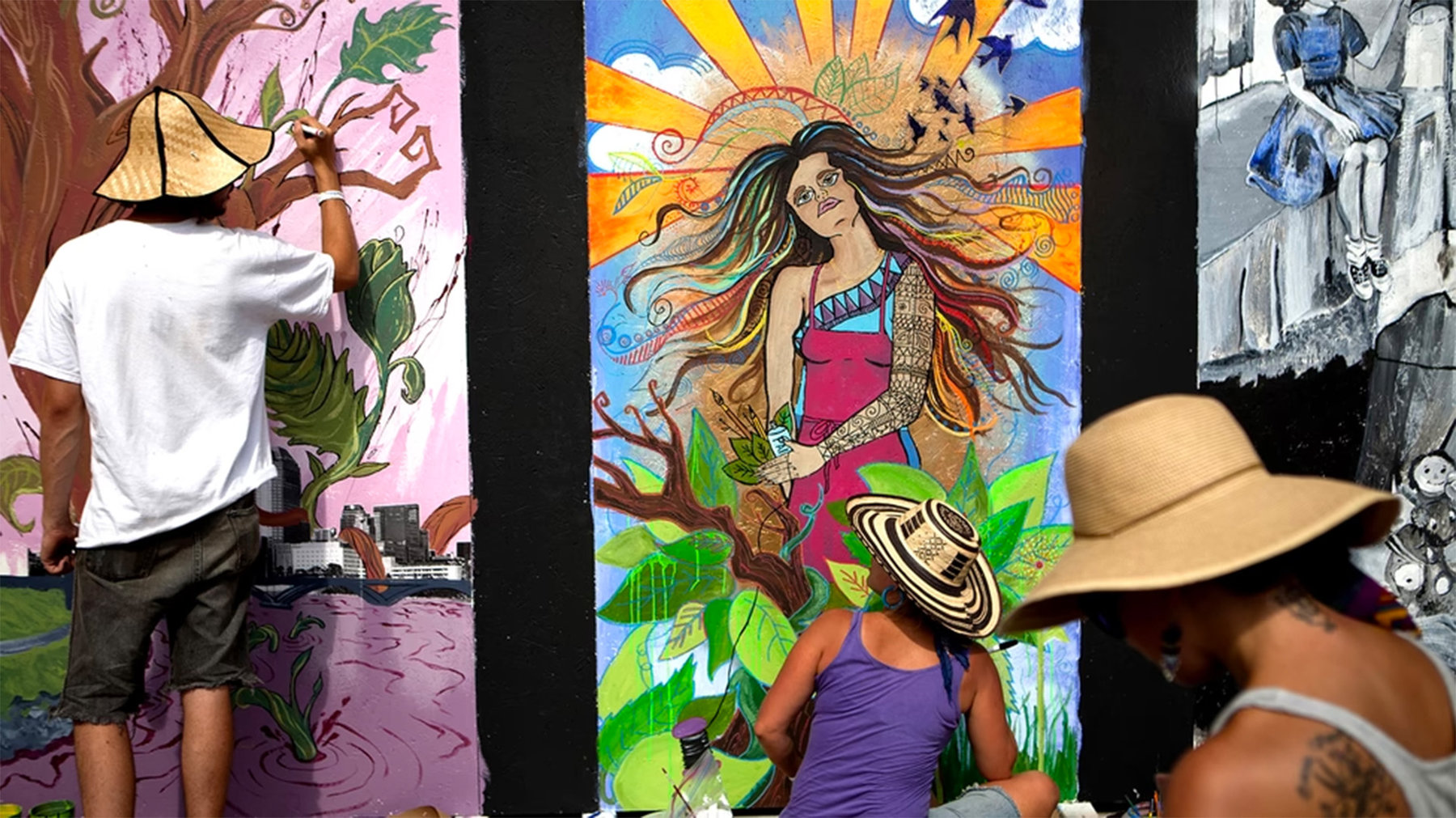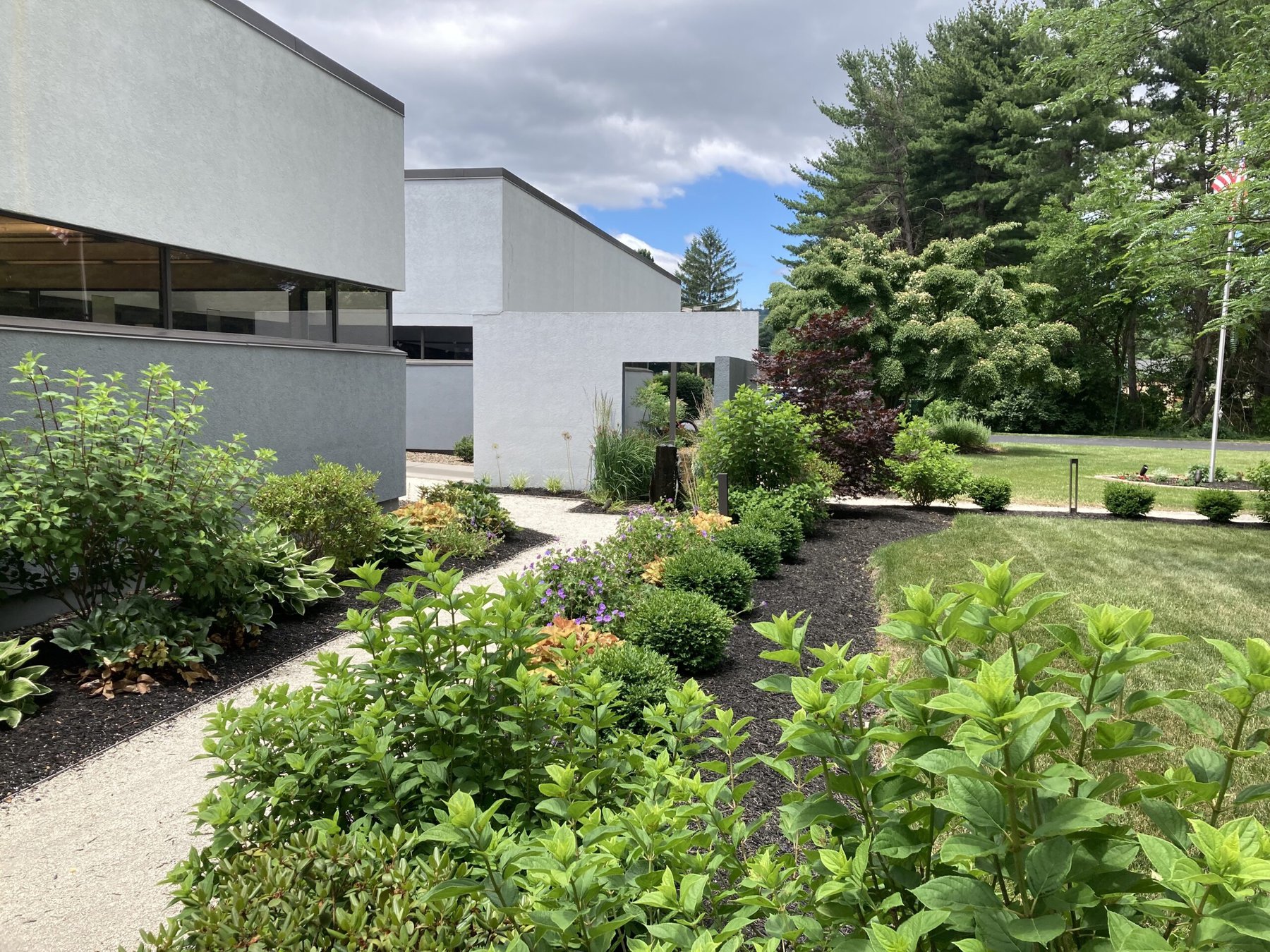Early last week, for the American Futures series here at The Atlantic, I posted the first part of my look into the efforts in Columbus, Ohio, to resuscitate the city’s oldest and poorest neighborhood, Franklinton. Let’s explore this some more.
The revitalization is gaining momentum because of the efforts of the city government, private-sector organizations, and a group of citizens who, through the sustained work of the Franklinton Development Association (FDA), have been working for more than 20 years to figure out how to do it right. The strategy that has gained some real traction is an effort to “rebrand” the eastern part of the area as the “Franklinton Arts District.”
The plan to make East Franklinton into a Creative Community District has been awarded the 2014 National Planning Excellence Award for Innovation in Economic Development & Planning by the American Planning Association, which created this video in celebration of the efforts (worth seeing as an overview of all this):
More importantly, the plan is succeeding in terms of real life on the ground. The crowds of artists, musicians, and spectators at the annual two-day Urban Scrawl are one small indicator of success. A more permanent sign is the presence of two facilities, separated by only a few hundred feet, that serve as the anchors to this arts district: the Columbus Idea Foundry, a “makerspace,” and 400 West Rich, home to art and design studios and an event and performance space.
Evoking the rhythms and cadence of Martin Luther King, Jr.’s “I Have a Dream” speech, Coleman talked about the oldest neighborhood in Columbus: “Franklinton is the birthplace of our leadership,” he began. Subsequent paragraphs led off with: “Franklinton is the birthplace of our perseverance…” and then “… the birthplace of our ingenuity … the birthplace of our compassion …”
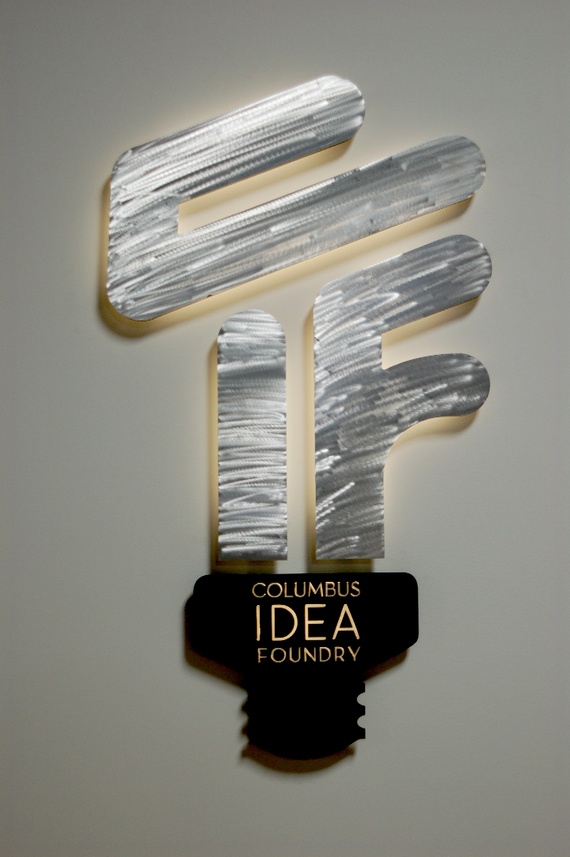
With the encouragement of the Columbus Foundation, a local philanthropy and seventh largest community foundation in the U.S., the FDA applied for and received a $350,000 grant from ArtPlace America, a national organization dedicated to improving communities by supporting “creative placemaking” efforts around the country. (Readers of the American Futures series may recall our profile of the Tides Institute and Museum of Art in Eastport, Maine, which also was a recipient of an ArtPlace grant.)
The FDA used the ArtPlace grant to renovate the first floor of the building to accommodate the needs of the Columbus Idea Foundry, which at the time was in a 24,000-square-foot space in northeast Columbus, having earlier graduated from somewhere much smaller. The renovation included improvements in the electrical and HVAC systems, upgrading of lighting, and the construction of walls for studios, offices, classrooms, and workrooms.
The Columbus Foundation also gave the FDA more than $85,000 in project support (legal fees, etc.) to help bring about the collaboration between FDA and the Idea Foundry and to get the makerspace into Franklinton.
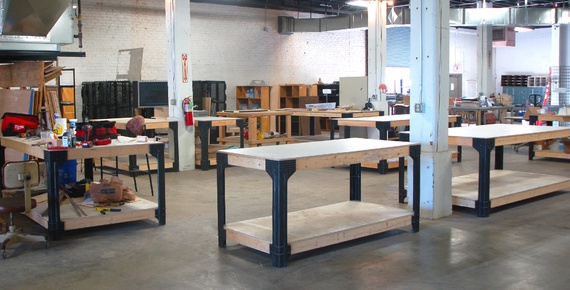
When I visited the Idea Foundry late on a Friday afternoon in early September with the FDA’s director, Jim Sweeney, I found a vast, bright, well-lit space, divided into separate work areas.
What all this adds up to, according to Casey McCarty, the Idea Foundry’s chief operating officer, who accompanied us on a tour of the facility, is “a community resource for democratized design and fabrication. We lower the barrier to entry for bringing ideas to life and to market, and that truly empowers entrepreneurs.”

After we had walked through the whole facility, stopping at various workstations while I gawked at many of the space-age tools, everybody was ready for a beer. The group of us left the Idea Foundry’s space, heading east to a local watering hole. But on our way, we stopped in the immediately adjacent building to see the work-in-progress facility of the Land-Grant Brewing Company, a new brewery opening soon in reclaimed warehouse space. Walt Keys, one of the four guys starting this venture into craft-brewing, told me they expect to produce about 2,000 barrels their first year. They also will have their own canning operation and a tap room that will serve parched locals. (Their official grand opening to the public is next Saturday, October 18th.)
We trekked another couple hundred feet, across West Town Street, arriving at Strongwater Food and Spirits, a lively and attractive bar and restaurant that caters to the growing community of artists and entrepreneurs who are transforming Franklinton. (That’s Strongwater at top left in the photo below, which shows the crowd at Columbus’s annual Independents’ Day festival, held a few weekends ago, this year in Franklinton.)
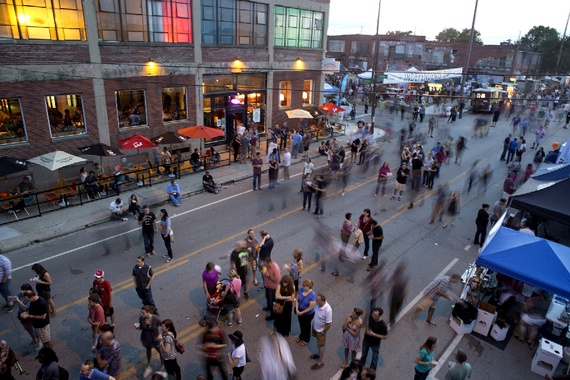
The place was packed with young people enjoying the happy-hour $3 craft beers and the menu of specialty cocktails, some of which are named for Franklinton boosters or locales: the Gin Sweeney (for the FDA’s director and longtime advocate for Franklinton), the Green Lawn Abbey (a martini named for a supposedly haunted grand mausoleum in a Franklinton cemetery), The Bottoms (after the neighborhood’s derogatory moniker), and the Scioto Margarita (for the river, which is prone to flooding). A couple of drinks also have a railroad theme, in tribute to the freight trains that still occasionally rumble slowly by on the tracks a mere 50 feet to the east.
The trendy restaurant gave way to space that’s more industrial in its feel—appropriately so, because the 105,000-square-foot building is the former home to the manufacturer of Oasis refrigerated drinking fountains. It’s now home to more than 100 artist studios, along with performance spaces, and of course the restaurant and bar. (You can see the websites of some of the artists here.) Coming soon to the space at 400 West Rich are private offices, reserved desks, and co-working spaces.
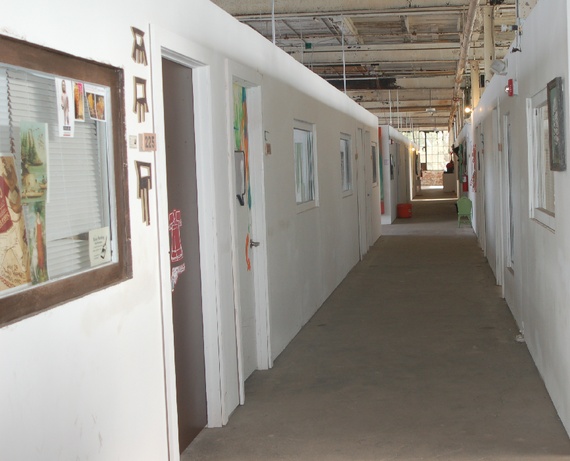
The monthly rents these artists pay for space at 400 West Rich are so low as to make them the object of envy from fellow artists in places like Boston, New York, and San Francisco. The studios rent anywhere from 60 cents to $1.10 a square foot. The typical monthly rent is about $175, and that includes heat and WiFi. Every space is filled, and there’s a waiting list to get in.
At the far end of the building, the group showed me the former loading dock that is now home to a “Dine-In” area, a place where local food trucks pull up at various times of day in the summer to bring good food and creative sustenance to the artists toiling away in the building. (Alas, Strongwater doesn’t open until 4:00 p.m.)
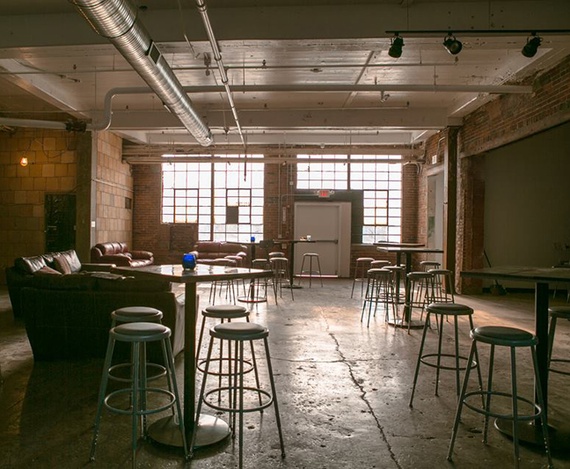
As we walked back toward Strongwater at the building’s other end, we passed a 3,500-square-foot performance space (shown at left) where, I’m told, events like a PechaKucha Night are held. (PechaKucha—for those of you as clueless as I—is an event intended for young designers to show their work in public and to network with other young designers. A PechaKucha presenter shows 20 slides, talking about each for 20 seconds. See the PechaKucha website for interesting videos.)

Soon, we were back at our table in Strongwater, where our drinks, untouched, awaited us, and where, over the next hour or so, I met more of the interesting young people whose lives and presence give meaning to the idea of a Franklinton arts district.
Mary Barczak stopped by our table to say hello. She shares a studio space with fellow artist Ira Tecson. She pays about 50 cents a square foot for her portion of the space, which she wanted to show me. Barczak is a photographer and painter, whose work tends to the surreal. (See her paper masks in photo below, and go here to check out the bizarre, cloaked, nun-like figures she calls “The Nones.”)

Back at the bar once again after seeing the Barczak/Tecson studio, I was introduced to Jessica Phelps, a photographer and photojournalist who works for the Newark Advocate, a daily newspaper that serves Newark, Ohio, and the surrounding county. Prior to working for the Advocate, Phelps traveled around Central and South America, and worked for 10 months for a newspaper in Costa Rica.

Phelps told me that she spends a lot of her free time photographing people in the Franklinton area. (You can see her gallery of Franklinton photos here.) Phelps became interested in the neighborhood through a friend who bought and rehabbed a house there. She gradually learned more about the history of the neighborhood and the direction in which Mayor Coleman wanted to take it. She spent time there, talking with the residents and taking photos. (You can see several of her photos in this piece.) Phelps finally decided to move into Franklinton, not only “to better document life there,” but also because she simply “fell in love with the energy of the neighborhood and the open directness of the people.”
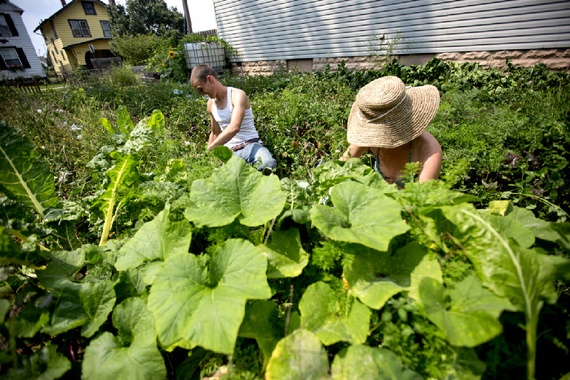
Before I left Strongwater and half of my second beer, I also met Nick Stanich, a maker and creator of a different sort. That is, he coaxes his product not out of a blank canvas but out of the raw ground: He grows food. Stanich, who is affiliated with the Food Innovation Center at Ohio State, is also the director of Franklinton Gardens, a nonprofit urban farm, located in Franklinton. It started seven years ago as a community garden on a little vacant lot; it now is a thriving network of seven gardens or food-production sites scattered throughout the Franklinton neighborhood. The organization aims to make fresh food available to residents in this “food desert” neighborhood, and to do so through sustainable methods of urban food production and local marketing efforts.
The mission statement of Franklinton Gardens contains, not surprisingly, references to “growing and sharing healthy food” and “promoting nutrition and active living.” But there are two other parts of it that seem completely of a piece with the shared mission of all the people I met in this lively and fascinating part of Columbus: “We are dedicated to … creating beauty in abandoned places … and building community with our neighbors.” More power to them all.

